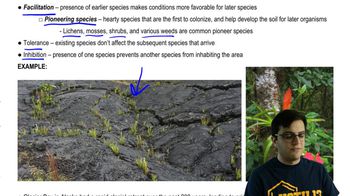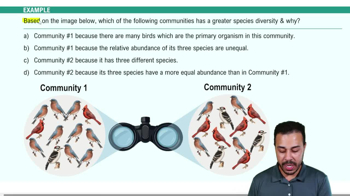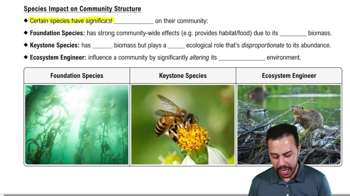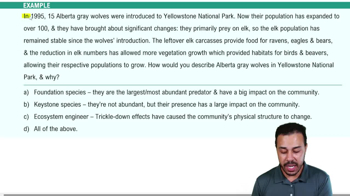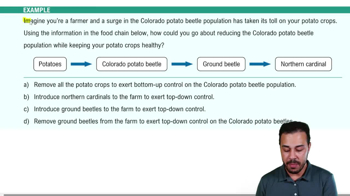Table of contents
- 1. Introduction to Biology2h 40m
- 2. Chemistry3h 40m
- 3. Water1h 26m
- 4. Biomolecules2h 23m
- 5. Cell Components2h 26m
- 6. The Membrane2h 31m
- 7. Energy and Metabolism2h 0m
- 8. Respiration2h 40m
- 9. Photosynthesis2h 49m
- 10. Cell Signaling59m
- 11. Cell Division2h 47m
- 12. Meiosis2h 0m
- 13. Mendelian Genetics4h 41m
- Introduction to Mendel's Experiments7m
- Genotype vs. Phenotype17m
- Punnett Squares13m
- Mendel's Experiments26m
- Mendel's Laws18m
- Monohybrid Crosses16m
- Test Crosses14m
- Dihybrid Crosses20m
- Punnett Square Probability26m
- Incomplete Dominance vs. Codominance20m
- Epistasis7m
- Non-Mendelian Genetics12m
- Pedigrees6m
- Autosomal Inheritance21m
- Sex-Linked Inheritance43m
- X-Inactivation9m
- 14. DNA Synthesis2h 27m
- 15. Gene Expression3h 20m
- 16. Regulation of Expression3h 31m
- Introduction to Regulation of Gene Expression13m
- Prokaryotic Gene Regulation via Operons27m
- The Lac Operon21m
- Glucose's Impact on Lac Operon25m
- The Trp Operon20m
- Review of the Lac Operon & Trp Operon11m
- Introduction to Eukaryotic Gene Regulation9m
- Eukaryotic Chromatin Modifications16m
- Eukaryotic Transcriptional Control22m
- Eukaryotic Post-Transcriptional Regulation28m
- Eukaryotic Post-Translational Regulation13m
- 17. Viruses37m
- 18. Biotechnology2h 58m
- 19. Genomics17m
- 20. Development1h 5m
- 21. Evolution3h 1m
- 22. Evolution of Populations3h 52m
- 23. Speciation1h 37m
- 24. History of Life on Earth2h 6m
- 25. Phylogeny2h 31m
- 26. Prokaryotes4h 59m
- 27. Protists1h 12m
- 28. Plants1h 22m
- 29. Fungi36m
- 30. Overview of Animals34m
- 31. Invertebrates1h 2m
- 32. Vertebrates50m
- 33. Plant Anatomy1h 3m
- 34. Vascular Plant Transport2m
- 35. Soil37m
- 36. Plant Reproduction47m
- 37. Plant Sensation and Response1h 9m
- 38. Animal Form and Function1h 19m
- 39. Digestive System10m
- 40. Circulatory System1h 57m
- 41. Immune System1h 12m
- 42. Osmoregulation and Excretion50m
- 43. Endocrine System4m
- 44. Animal Reproduction2m
- 45. Nervous System55m
- 46. Sensory Systems46m
- 47. Muscle Systems23m
- 48. Ecology3h 11m
- Introduction to Ecology20m
- Biogeography14m
- Earth's Climate Patterns50m
- Introduction to Terrestrial Biomes10m
- Terrestrial Biomes: Near Equator13m
- Terrestrial Biomes: Temperate Regions10m
- Terrestrial Biomes: Northern Regions15m
- Introduction to Aquatic Biomes27m
- Freshwater Aquatic Biomes14m
- Marine Aquatic Biomes13m
- 49. Animal Behavior28m
- 50. Population Ecology3h 41m
- Introduction to Population Ecology28m
- Population Sampling Methods23m
- Life History12m
- Population Demography17m
- Factors Limiting Population Growth14m
- Introduction to Population Growth Models22m
- Linear Population Growth6m
- Exponential Population Growth29m
- Logistic Population Growth32m
- r/K Selection10m
- The Human Population22m
- 51. Community Ecology2h 46m
- Introduction to Community Ecology2m
- Introduction to Community Interactions9m
- Community Interactions: Competition (-/-)38m
- Community Interactions: Exploitation (+/-)23m
- Community Interactions: Mutualism (+/+) & Commensalism (+/0)9m
- Community Structure35m
- Community Dynamics26m
- Geographic Impact on Communities21m
- 52. Ecosystems2h 36m
- 53. Conservation Biology24m
51. Community Ecology
Community Structure
Problem 4b
Textbook Question
Textbook QuestionPioneer species tend to have high and lower survivorship.
 Verified step by step guidance
Verified step by step guidance1
Identify the missing term: Pioneer species are the first to colonize disturbed or new habitats and have specific traits that allow them to thrive in these environments.
Consider the traits of pioneer species: They typically grow quickly, reproduce early, and produce many offspring. These traits are associated with a specific type of reproductive strategy.
Recognize the reproductive strategy: The traits described are characteristic of an r-selected strategy, which focuses on high growth rates, and taking advantage of less crowded ecological niches.
Connect the strategy to survivorship: In r-selected species, the survivorship tends to be lower because many offspring are produced but with less parental care, leading to a higher mortality at younger ages.
Conclude the missing term: Pioneer species tend to have high 'reproductive rates' and lower survivorship.
Recommended similar problem, with video answer:
 Verified Solution
Verified SolutionThis video solution was recommended by our tutors as helpful for the problem above
Video duration:
2mPlay a video:
Was this helpful?
Key Concepts
Here are the essential concepts you must grasp in order to answer the question correctly.
Pioneer Species
Pioneer species are the first organisms to colonize previously disrupted or damaged ecosystems. They play a crucial role in ecological succession by preparing the environment for subsequent species. These organisms are typically hardy and can thrive in harsh conditions, which allows them to establish themselves in barren landscapes.
Recommended video:

Biological Species Concept
Ecological Succession
Ecological succession is the process by which ecosystems change and develop over time. It involves a series of stages where different communities of organisms replace one another, leading to a more stable and diverse ecosystem. Pioneer species initiate this process, followed by intermediate and climax communities that establish a more complex ecological structure.
Recommended video:
Guided course
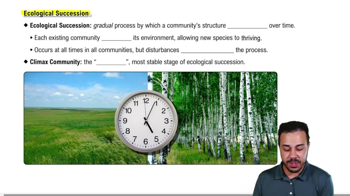
Ecological Succession
Survivorship
Survivorship refers to the likelihood of an organism surviving to a particular age or stage in its life cycle. In the context of pioneer species, they often exhibit lower survivorship due to their exposure to extreme environmental conditions and competition. Understanding survivorship curves helps ecologists predict population dynamics and the long-term success of species in an ecosystem.
Recommended video:
Guided course

Survivorship

 4:25m
4:25mWatch next
Master Community Structure with a bite sized video explanation from Jason Amores Sumpter
Start learningRelated Videos
Related Practice






